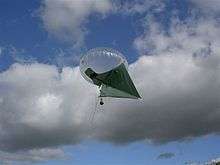Kytoon

A kytoon or kite balloon is a tethered aircraft which obtains some of its lift dynamically as a heavier-than-air kite and the rest aerostatically as a lighter-than-air balloon.[1] The word is a portmanteau of kite and balloon.
The primary advantage of a kytoon is that it remains in a reasonably stable position above the tether point, irrespective of the strength of wind, whereas ordinary balloons and kites are less stable.[1]
The kytoon has been used for many purposes both civil and military.
History
The hybrid kite-balloon was invented by Domina Jalbert[2] in 1944 as patent US2431938. and later became known as the kytoon. He furthered his attention on kite balloons also with another patent filed on August 31, 1945 titled "Kite Balloon"
The Allsopp Helikite is a modern helium-filled example.
Stability
A captive balloon tends to drift down the wind and the harder the wind blows, the further the balloon drifts. This leans the tether over at an angle, pulling the balloon lower. On a kytoon, the kite action lifts the balloon, counteracting this pull and holding the kytoon in position. As the wind blows harder, the kite action lifts harder. This can provide good stability even in strong winds.
In low or gusty winds a kite can nose-dive, losing a large amount of height even if it recovers. Because a kytoon is buoyant it does not nose-dive and remains in position even in relatively still air.[2]
Applications
Applications of the kytoon have included:
- Raise communications antenna aloft.[2][3][4]
- Commercial advertising[2]
- Low-level aerial photography[2]
- Raise wind turbines for generating electricity
- Raise emergency signals in calm or wind
- Meteorological measurements[5]
- Sighting target for conducting geographical surveys[2]
- Scare birds away from crops
- Recreation
See also
References
- 1 2 Popular Mechanics Mar 1958
- 1 2 3 4 5 6 "Kite + balloon = kytoon", Popular Mechanics, August 1950, Page 80.
- ↑ RESPONSE OF A KYTOON TO VERTICAL AND HORIZONTAL GUSTS
- ↑ Balloon Production
- ↑ Meteorlogical observation measurements
